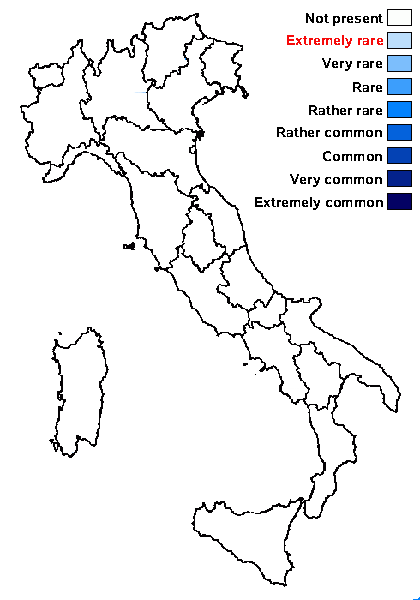Rinodina mayrhoferi A. Crespo
Lazaroa, 5: 261, 1984 ("1983")
Synonyms:
Distribution:
Description: Thallus crustose-areolate to subsquamulose, rarely reduced to a few scattered granules, the areoles up to 1 mm wide, blue-grey, often with a brownish tinge, ascending to erect, the margins weakly lobed. Upper cortex paraplectenchymatous; medulla lax; lower cortex poorly developed. Apothecia lecanorine, sessile, 0.3-0.6 mm across, with a concave to slightly convex, black disc and a entire, persistent, smooth proper margin which often appears minutely farinose due to numerous projecting hyphae. Thalline exciple corticate, the cortex 10-20 µm wide laterally, paraplectenchymatous, of 5-7 µm wide, thin-walled cells; epithecium blue-grey to blue-black, K+, C+ and N+ violet; hymenium colourless, up to 80 µm high; paraphyses 1.5-2 µm thick at mid-level, the apical cell 2-2.5 µm wide; hypothecium colourless. Asci 8-spored, clavate, the K/I+ blue tholus penetrated by a faintly amyloid apical cushion with parallel or diverging flanks, the wall K/I-, surrounded by a K/I+ blue outer layer, Lecanora-type. Ascospores 1-septate, pigmented, ellipsoid, (15-)28-23 x 8-10 µm, with two darker bands over each cell, Bicincta-type, with a minutely warted wall, without a distinct torus, with ontogeny of type B (apical thickenings visible before the insertion of the septum). Photobiont chlorococcoid. Spot tests: thallus, thalline margin and epithecium K+ violet, C+ violet, P-, N+ violet. Chemistry: thallus without lichen substances, except a K+ and N+ violet pigment in the cortex and in the epithecium.Note: a Mediterranean-continental species known from the central parts of the Iberian Peninsula to Turkey, growing on shrubs (especially Juniperus) in dry-continental regions; to be looked for in Italy, especially in the most continental parts of Sardinia.
Growth form: Crustose
Substrata: bark
Photobiont: green algae other than Trentepohlia
Reproductive strategy: mainly sexual
Subcontinental: restricted to areas with a dry-subcontinental climate (e.g. dry Alpine valleys, parts of Mediterranean Italy)

Predictive model
Growth form: Crustose
Substrata: bark
Photobiont: green algae other than Trentepohlia
Reproductive strategy: mainly sexual
Subcontinental: restricted to areas with a dry-subcontinental climate (e.g. dry Alpine valleys, parts of Mediterranean Italy)

Predictive model
 INDEX FUNGORUM
INDEX FUNGORUM
 GBIF
GBIF

